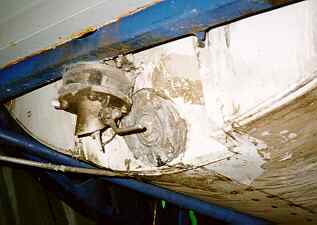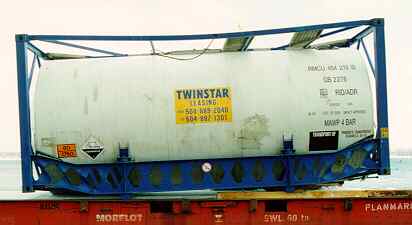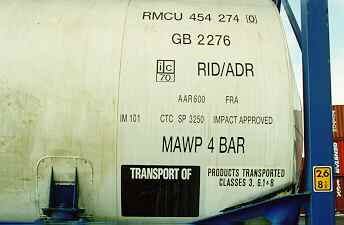Dangerous good spill
in No. 1 Hold of the Cypriot-flag
Container Ship "MOR U.K."
in the North Atlantic
The Transportation Safety Board of Canada (TSB) investigated this occurrence for the purpose of advancing transportation safety. It is not the function of the Board to assign fault or determine civil or criminal liability. This report is not created for use in the context of legal, disciplinary or other proceedings. See Ownership and use of content. Masculine pronouns and position titles may be used to signify all genders to comply with the Canadian Transportation Accident Investigation and Safety Board Act (S.C. 1989, c. 3).
Summary
While the "MOR U.K." was crossing the Atlantic, the container ship sailed into adverse weather conditions. The rolling, pitching, heaving and pounding moments to which the vessel was subjected stressed the metal support structure of a tank container to the limit of its tensile strength. As a result of the support structure bending against the tank, dangerous and corrosive goods leaked out and spilled into No. 1 hold. These goods were discharged into the sea with the permission of the Canadian Coast Guard. No one appears to have been incapacitated as a result of this spill.
Factual information
Particulars of the vessel
| Name | "MOR U.K." |
|---|---|
| Limassol, Cyprus | Port of Registry |
| Flag | Cypriot |
| Official number | 7614367 |
| Type | Container ship |
| Gross tonnage | 17,304 |
| Length | 169.75 m |
| Draught | Forward: 6.5 m Aft: 8.4 m |
| Built | 1979, VEB Warnowwerft Warnemuende, Germany |
| Propulsion | One Sulzer engine developing 12,799 kW, driving a single fixed-pitch propeller |
| Owners | Uniship Shipping & Trading S.A. Piraeus, Greece |
On 16 February 1995, the container ship "MOR U.K.", laden with containers, was under way in the North Atlantic bound for Montreal, Quebec. During the crossing, the vessel encountered a storm with 55-knot westerly winds blowing for two days. The vessel sailed westward head on to the wind at an estimated speed of 10 knots. The bow pounded violently against the waves and vibrations were felt throughout the ship.
During a routine inspection in No. 1 hold, a leak was discovered from tank container No. RMCU 454 274 (0) holding 25,576 kg of BORINO. This product has the property of reacting chemically with metals to release hydrogen. The girders forming the metal support structure framing the tank were bent and the tap was damaged. The crew tried to staunch the leak, but was only partly successful. Foam was noticed in the bilges.
On 18 February 1995, the master requested permission from the Canadian authorities to discharge into the sea an estimated one and a half tonnes of the product which had spilled into the hold. Permission was granted, and pumping was done at a low flow rate from position 46°51.6′N, 044°07′W. The quantity of BORINO remaining in the container was checked on arrival at destination, and it was concluded that approximately eight tonnes of product had been discharged into the sea.
Analysis
The tank container was built in June 1993 to US Department of Transport (US DOT) specification IM 101. Although the International Maritime Dangerous Goods (IMDG) Regulations applied at the time of the occurrence, the tank had been certificated to meet 49CFR, and, therefore, should also have met those requirements. The IMDG vertical loading requirement is 2W (where W represents the weight of the tank, its fittings and its contents) as compared with the 49CFR which states that the calculated stress of the tank support structure must not exceed 80 per cent of its tensile strength when the tank is subjected to a vertical inertial load factor of 3W.
If the tank had been loaded to its maximum permissible weight of 29,030 kg, excluding the weight of the frame, a vertical inertial load factor of between 3.25 and 3.5W would have been required to cause this failure. The actual tank weighed somewhat less at 28,246 kg and would have required a slightly higher vertical inertial load factor of 3.3 to 3.6W to fail. However, because of the location of the container in the forward hold, the rough seas experienced during the storm and the speed of the ship, the container would have been subjected to multiple high impact loads because of the ship's pitching and pounding.
Further, given that containers are free to move within their guides, and that only one container was stacked on top of the failed container, it is possible that the failed container was able to move vertically from its footings while the vessel was pitching and pounding, causing significant vertical impact loads.
The failed container was filled to 77 per cent of its capacity. As per the IM 101 requirements, tanks containing between 20 and 80 per cent of their capacity should not be offered for transport by ship, and, therefore, the failed container was marginally underfilled. This could have resulted in liquid surge, shifting the centre of gravity to one end. This effect, combined with vertical acceleration, can significantly increase the vertical loads at one end. The IMDG Code has a similar requirement, although the exact ullage allowance must be determined using a formula which takes into account the temperatures and expansion characteristics of the contents.
The damage pattern on the container was consistent with the damage having occurred as a result of operational loads during a storm at sea. However, the possibility exists that the longitudinal I-beams may have been slightly buckled or otherwise damaged prior to loading. If a buckle was present on the longitudinal I-beam prior to loading aboard the ship, the load required to cause the type of failure observed would have been much less than on an undamaged frame.
To reduce the damage resulting from handling in the railway transportation system, and to facilitate observation of such damage, the container manufacturer has instituted a 36-ton upgrade of the unit by welding diagonal braces in two additional holes in the web, stiffening the latter and increasing its buckling strength. To date, more than 46 per cent of the 1,448 tank containers produced in the 30-ton series have been upgraded to the 36-ton level. At this time, there has been no reported failure of the new 36,000 kg-rated tank container frame.
The chemical that spilled into the No. 1 hold of the "MOR U.K." is listed in the IMDG Code published by the International Maritime Organization (IMO). Its properties are given under numerical index UN No. 1760. Its safety data sheet indicates that it is a Class 8 product, which means it is corrosive. This solution is composed of sodium borohydride, sodium hydroxide and water, and its properties are to react chemically when exposed to metals to release hydrogen.
Findings
- The vessel sailed westward head on to the wind at an estimated speed of 10 knots.
- A spill of a corrosive chemical occurred in No. 1 hold when the ship encountered adverse weather conditions.
- The vessel had to discharge an estimated eight tonnes of the chemical into the sea, with the permission of the Canadian Coast Guard, in order to stop the formation of hydrogen in the holds, as it might have caused an explosion.
- If the tank had been loaded to its maximum permissible weight of 29,030 kg, excluding the weight of the frame, a vertical inertial load factor of between 3.25 and 3.5W would have been required to cause this failure.
- The metal support structure of the tank container was damaged by the acceleration forces generated by the heaving and pounding of the vessel in the storm.
- Established norms require that a container be filled to 80 per cent of its capacity for shipment by sea. At 77 per cent of its capacity, the failed container was marginally underfilled.
Causes and Contributing Factors
The failure of the metal support structure of the tank container was probably caused by the combination of several factors, including the storage location of the containers in the forward hold, the severe storm conditions, the speed of the ship during the storm, the marginal ullage conditions, and possible pre-loading damage.
Action Taken
Following this occurrence, Marine Safety Information Letter No. 4/95 and TSB Engineering Laboratory Report LP 32/95 on the structural analysis of the tank container were forwarded to Transport Canada. In addition, TC-Marine was apprised, via Marine Safety Advisory No. 08/96, of the mode of failure of the container and of the adequacy of present inspection procedures to account for such failures.
This report concludes the Transportation Safety Board's investigation into this occurrence. Consequently, the Board, consisting of Chairperson, John W. Stants, and members Zita Brunet and Maurice Harquail, authorized the release of this report on .





